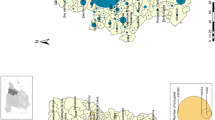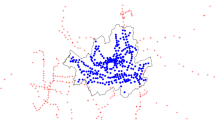Abstract
The uneven distribution of centres in settlement systems and the non-homogeneity of social-economic space are the stimuli for the existence of spatial interactions. The interactions, that manifest the changes in their intensity with an increasing distance from a centre, can be described by distance-decay functions. This paper presents the construction, analysis and typology of distance-decay functions for regional centres of Slovakia using the daily travel-to-work flow data. Apart from an estimation of individual distance decay functions for each centre, a universal distance-decay function is also constructed through more sophisticated statistical analyses, where not only distance is the input parameter, but also the population of a centre. The resulting distance-decay functions have a wide range of uses in spatial interaction modelling (commuting, transportation, etc.). They also define the range of spatial influence of regional centres and therefore they can be used, for example, in proposals and revisions for the administrative division of a territory.












Similar content being viewed by others
References
Aubigny GD’, Caldaza C, Grasland C, Viho G, Vincent J-M (2000) Approche statistique des modèles d’interaction spatiale. Cybergéo
Box GEP, Cox DR (1964) An analysis of transformations. J R Stat Soc B 26:211–252
Cheng J, Bertolini L (2013) Measuring urban job accessibility with distance decay, competition and diversity. J Transp Geogr 30:100–109
Christaller W (1933) Central places in southern Germany (trans. CW Baskin, 1966). Prentice-Hall, Englewood Cliffs
Converse PD (1949) New laws of retail gravitation. J Mark 14(3):37–384
De Vries JJ, Nijkamp P, Rietveld P (2009) Exponential or power distance-decay for commuting? An alternative specification. Environ Plan A 41:461–480
Dougherty M (1995) A review of neural networks applied to transport. Transp Res C Emerg 3:247–260
Džupinová E, Halás M, Horňák M, Hurbánek P, Káčerová M, Michniak D, Ondoš S, Rochovská A (2008) Periférnosť a priestorová polarizácia na území Slovenska. Bratislava, Geo-grafika
Fotheringham AS (1981) Spatial structure and distance-decay parameters. Ann Assoc Am Geogr 71:425–436
Fujita M, Krugman P, Venables AJ (2001) The spatial economy: cities, regions, and international trade. MIT Press, Cambridge
Gopal S, Fischer MM (1996) Learning in single hidden-layer feedforward network: backpropagation in a spatial interaction modeling context. Geogr Anal 28:38–55
Grasland C (1996) A smoothing method based on multiscalar neighbourhood functions of potential. The Hypercarte Project, Working Paper 1
Grasland C, Potrykowska A (2002) Mesures de la proximité spatial: les migrations résidentielles à Varsovie. L’Espace géographique 31:208–226
Gutiérrez J, Cardozo OD, García-Palomares JC (2011) Transit ridership forecasting at station level: an approach based on distance-decay weighted regression. J Transp Geogr 19:1081–1092
Halás M (2005) Dopravný potenciál regiónov Slovenska. Geografie 110:257–270
Halás M (2008) Priestorová polarizácia spoločnosti s detailným pohľadom na periférne regióny Slovenska. Sociol Cas 44:349–369
Halás M (2014) Modelovanie priestorového usporiadania a dichotómie centrum–periféria. Geografie 119:384–405
Halás M, Klapka P (2012) Contribution to regional division of Slovakia based on the application of the Reilly’s model. Hungarian geographical bulletin 61:237–255
Halás M, Klapka P, Kladivo P (2014) Distance-decay functions for daily travel-to-work flows. J Transp Geogr 35:107–119
Heldt Cassel S, Macuchova Z, Rudholm N, Rydell A (2013) Willingness to commute long distance among job seekers in Dalarna, Sweden. J Transp Geogr 28:49–55
Himanen V, Nijkamp P, Reggiani A (1998) Neural networks in transport applications. Ashgate, Brookfield
Huff DL (1964) Defining and estimating a trading area. J Marketing 28(3):34–38
Ibeas Á, Cordera R, dell’Olio L, Coppola P (2013) Modelling the spatial interactions between workplace and residential location. Transp Res A Pol 49:110–122
Johansson B, Klaesson J, Olsson M (2002) Time distances and labor market integration. Pap Reg Sci 81:305–327
Klapka P, Erlebach M, Král O, Lehnert M, Mička T (2013) The footfall of shopping centres in Olomouc (Czech Republic): an application of the gravity model. Morav Geogr Rep 21(3):12–26
Klapka P, Halás M, Erlebach M, Tonev P, Bednář M (2014) A multistage agglomerative approach for defining functional regions of the Czech Republic: the use of 2001 commuting data. Morav Geogr Rep 22(4):2–13
Korec P (2005) Regionálny rozvoj Slovenska v rokoch 1989–2004. Bratislava, Geo-grafika
Kraft S, Blažek J (2012) Spatial interactions and regionalisation of the Vysočina Region using the gravity models. Acta Universitatis Palackianae Olomucensis. Geographica 43:65–82
Kraft S, Halás M, Vančura M (2014) The delimitation of urban hinterlands based on transport flows: a case study of regional capitals in the Czech Republic. Morav Geogr Rep 22(1):24–32
Liu Y, Sui Z, Kang C, Gao Y (2014) Uncovering patterns of inter-urban trip and spatial interaction from social media check-in data. PLoS ONE 9:e86026
Lukniš M (1985) Regionálne členenie Slovenskej socialistickej republiky z hľadiska jej racionálneho rozvoja. Geografický časopis 37:137–163
Mamuna SA, Lownes NE, Osleeb JP, Bertolaccini K (2013) A method to define public transit opportunity space. J Transp Geogr 28:144–154
Martínez LM, Viegas JM (2013) A new approach to modelling distance-decay functions for accessibility assessment in transport studies. J Transp Geogr 26:87–96
Morlon H, Chuyong G, Condit R, Hubbell S, Kenfack D, Thomas D, Valencia R, Green JL (2008) A general framework for the distance–decay of similarity in ecological communities. Ecol Lett 11:904–917
Mozolin M (1997) Spatial interaction modeling with an artificial neural network. Discussion Paper. Series 97-1, Athens, University of Georgia
Mozolin M, Thill J-C, Lynn Usery E (2000) Trip distribution forecasting with multilayer perceptron neural networks: a critical evaluation. Transp Res B Methodol 34:53–73
O´Kelly EM, Niedzielski MA (2009) Are long commute distance inefficient and disorderly? Environ Plan A 41:2741–2759
Ortúzar JD, Willumsen LG (2011) Modelling transport. Wiley, New York
Ravenstein EG (1885) The laws of migration. J R Stat Soc 48:167–235
Řehák S, Halás M, Klapka P (2009) Několik poznámek k možnostem aplikace Reillyho modelu. Geographia Moravica 1:47–58
Reilly WJ (1929) Methods for the study of retail relationships. University of Texas Bulletin No. 2944. University of Texas, Austin
Reilly WJ (1931) The law of retail gravitation. Knickerbocker Press, New York
Richards FJ (1959) A flexible growth function for empirical use. J Exp Bot 10:290–300
Rosina K, Hurbánek P (2013) Internet availability as an indicator of peripherality in Slovakia. Morav Geogr Rep 21:16–24
Roth C, Kang SM, Batty M, Barthélemy M (2011) Structure of urban movements: polycentric activity and entangled hierarchical flows. PLoS ONE 6:e15923
Sileshi GW, Arshad MA (2012) Application of distance–decay models for inferences about termite mound-induced patterns in dryland ecosystems. J Arid Environ 77:138–148
Soininen J, Mcdonald R, Hillebrand H (2007) The distance decay of similarity in ecological communities. Ecography 30:3–12
Stewart JQ (1948) Demographic gravitation: evidence and applications. Sociometry 11:31–58
Taylor PJ (1971) Distance transformation and distance decay function. Geogr Anal 3:221–238
Taylor PJ, Hoyler M, Verbruggen R (2010) External urban relational process: introducing central flow theory to complement central place theory. Urban Studies 47:2803–2818
Thompson DL (1966) Future directions in retail area research. Econ Geogr 42:1–18
Tiefelsdorf M (2003) Misspecifications in interaction model distance decay relations: a spatial structure effect. J Geogr Syst 5:25–50
Timmermans H, Van der Waerden P, Alves M, Polak J, Ellis S, Harvey AS, Kurose S, Zandee R (2003) Spatial context and the complexity of daily travel patterns: an international comparison. J Transp Geogr 11:37–46
Ubøe J (2004) Aggregation of gravity models for journeys to work. Environ Plan A 36:715–729
Willigers J, Floor H (2007) Accessibility indicators for location choices of offices: an application to the intraregional distributive effects of high-speed rail in the Netherlands. Environ Plann A 39:2086–2098
Acknowledgments
This work was supported by the Internal Grant Agency of the Palacký University Olomouc under project Grant Geographical structures and interactions: analysis and modelling of the organisation of space [Number IGA_PrF_2015_006].
Author information
Authors and Affiliations
Corresponding author
Rights and permissions
About this article
Cite this article
Halás, M., Klapka, P. Spatial influence of regional centres of Slovakia: analysis based on the distance-decay function. Rend. Fis. Acc. Lincei 26, 169–185 (2015). https://doi.org/10.1007/s12210-015-0387-4
Received:
Accepted:
Published:
Issue Date:
DOI: https://doi.org/10.1007/s12210-015-0387-4




